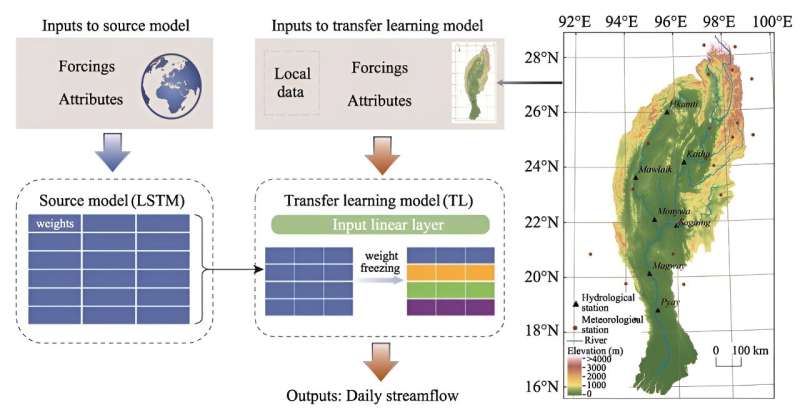This article has been reviewed according to Science X's editorial process and policies. Editors have highlighted the following attributes while ensuring the content's credibility:
fact-checked
proofread
Transboundary streamflow forecasting enhanced by transfer learning: A watershed moment in hydrology

A recent study is transforming the field of streamflow prediction. By harnessing the power of transfer learning, researchers have developed a model that significantly boosts the precision of daily streamflow forecasts.
This breakthrough provides an indispensable tool for bolstering water resource management and crafting effective climate change mitigation strategies.
Critical for securing water supplies and gauging climate change effects, streamflow modeling often falls short due to the spotty global distribution of gauges and a dearth of data in expansive transboundary basins. The complex interplay of hydrological processes in these areas, further complicated by data scarcity, has long called for a novel modeling approach that can adeptly navigate these constraints.
In a publication in the Journal of Geographical Sciences, a joint research team from Yunnan University and Pennsylvania State University has unveiled a transfer learning framework. This model excels at predicting daily streamflow in regions like the Dulong-Irrawaddy River Basin, which has been historically overlooked due to data limitations.
The performance not only surpasses that of conventional process-based models but also demonstrates an impressive adaptability to the basin's distinct hydrological features. The sensitivity analysis of the model reveals its adeptness at capturing intricate, nonlinear interactions among variables, while the integrated gradients analysis underscores its capability to delineate diverse flow patterns and spatial variations.
These insights suggest that the model can profoundly deepen our understanding of hydrological processes within large-scale catchments.
Dr. Ma Kai, a principal investigator and co-author of the study, says, "This research not only meets the urgent demand for reliable streamflow predictions in regions with limited data, but also paves the way for a more profound comprehension of the complex dynamics governing our hydrological systems."
The study's findings are set to have far-reaching implications, presenting a transformative tool for water resource stewardship in transboundary basins.
The advent of this transfer learning approach signals a paradigm shift in water resource forecasting and management, offering robust solutions to the challenges posed by data scarcity and climate change, and thereby fortifying water security in vulnerable regions.
More information: Kai Ma et al, Transfer learning framework for streamflow prediction in large-scale transboundary catchments: Sensitivity analysis and applicability in data-scarce basins, Journal of Geographical Sciences (2024). DOI: 10.1007/s11442-024-2235-x
Provided by IGSNRR CAS




















